Understanding Smart Watch Body Measurement Capabilities
The Evolution of Smart Watch Health Features
Smart watches have come a long way since their inception. They started as simple devices for telling time and setting alarms. Now, they are powerful health trackers. The first major health feature was step counting. This was followed by heart rate monitoring. Today's smart watches can do much more.

They can track sleep patterns, measure blood oxygen levels, and even detect falls. Some can even take ECG readings. The evolution has been rapid and impressive. Each year brings new features and improved accuracy. This progress has made smart watches valuable tools for health monitoring.
Key Technologies Enabling Smart Watch Body Measurements
Several key technologies make body measurements possible in smart watches. Sensors play a crucial role. These include accelerometers, gyroscopes, and optical sensors. Accelerometers detect movement and help count steps. Gyroscopes measure orientation and rotation.
Optical sensors use light to measure heart rate and blood oxygen levels. Some watches also use bioelectrical impedance analysis. This technology sends a small electrical current through the body. It can estimate body composition, including fat percentage. Advanced algorithms process all this data. They turn raw sensor readings into useful health insights.
Top Smart Watches with Advanced Body Measurement Tools
Comparing Popular Smart Watches for Health and Wellness
Several smart watches stand out for their body measurement features. The Apple Watch Series 8 is a top contender. It offers heart rate monitoring, ECG, and blood oxygen measurement. It also has a new temperature sensor for cycle tracking. The Samsung Galaxy Watch 5 is another strong option. It includes body composition analysis and sleep tracking.

The Fitbit Sense 2 focuses heavily on stress management. It has an EDA sensor to measure stress responses. The Garmin Fenix 7 is great for athletes. It offers advanced metrics for various sports. Each watch has its strengths. Some focus on general health, while others target specific needs like fitness or stress management.
How To Choose the Right Smart Watch for Body Measurement
Choosing the right smart watch depends on your needs. Consider what health aspects you want to track. If you're an athlete, look for watches with sports-specific features. If you have heart concerns, prioritize ECG and heart rate variability. Think about compatibility with your smartphone. Apple Watches work best with iPhones, while others are more versatile.
Battery life is another important factor. Some watches need daily charging, while others last a week or more. Comfort and design matter too. You'll wear this device often, so make sure it feels good. Finally, consider your budget. Prices vary widely, from budget-friendly options to premium devices.
The Future of Smart Watch Body Measurement Innovation
Upcoming Trends in Smart Watch Health Features
The future of smart watch technology looks exciting. We can expect even more advanced health features. Non-invasive blood glucose monitoring is a major goal. This would be a game-changer for people with diabetes. Continuous blood pressure monitoring is another area of focus. Current methods require frequent calibration.

Improved sleep tracking is also on the horizon. This includes better detection of sleep stages and sleep disorders. Mental health monitoring is gaining attention too. Watches may soon help detect anxiety and depression. Some companies are working on sweat analysis. This could provide insights into hydration and nutrition.
The Impact of AI and Machine Learning on Smart Watch Technology
AI and machine learning are revolutionizing smart watch technology. These tools help make sense of the vast amount of data collected. They can spot patterns that humans might miss. This leads to more accurate health predictions and personalized advice. AI can learn from your habits and provide tailored recommendations.
For example, it might suggest when to exercise based on your schedule and energy levels. Machine learning models are getting better at detecting health anomalies. They might spot signs of conditions like atrial fibrillation or sleep apnea. As these technologies improve, smart watches will become even more powerful health tools. They may even help predict and prevent health issues before they become serious.




Leave a comment
This site is protected by hCaptcha and the hCaptcha Privacy Policy and Terms of Service apply.